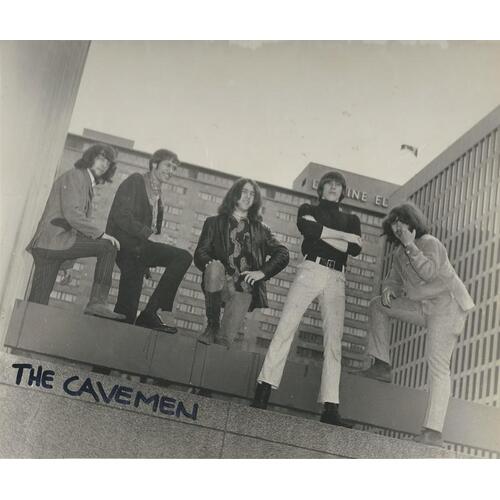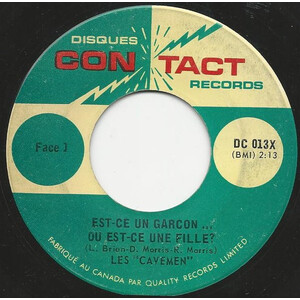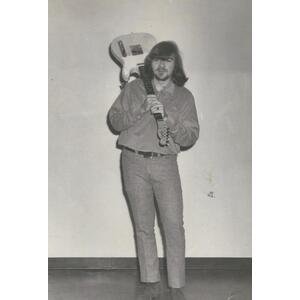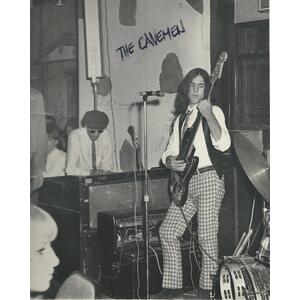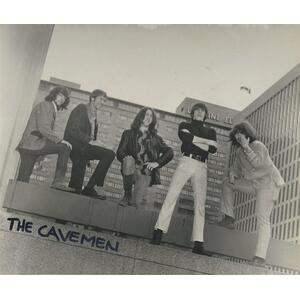Cavemen
Websites:
https://citizenfreak.com/artists/97054-jaguars-les, https://citizenfreak.com/artists/110457-arthur
Origin:
Jonquière, Québec, 🇨🇦
Biography:
Les Cavemen – Quebec’s Wildest Garage Rock Band
Emerging in 1964, Les Cavemen were one of Quebec’s most outrageous and theatrical garage rock bands of the 1960s. Known for their prehistoric-themed stage presence, primitive rock sound, and raucous energy, they quickly became a staple of Montreal’s nightlife, embodying the raw, rebellious spirit of the era.
The Cavemen Aesthetic – The Wildest Show in Quebec
Les Cavemen weren’t just a band - they were a spectacle. Dressed in real sheepskin caveman costumes, sporting waist-length hair and thick beards, they fully committed to their Stone Age theme. Their live shows were wild, humorous, and full of raw garage energy, making them a true novelty in the Quebec rock scene.
The band’s original lineup included:
Pierre St-Onge: bass
Normand St-Onge: drums
Pierre Parenteau: guitar
Joe Steiner: vocals, saxophone
Steiner was an unforgettable frontman, known for his massive afro, thick black square glasses, and animated stage presence. He embodied the band’s caveman aesthetic, delivering a performance that was as chaotic as it was captivating.
A Garage Rock Classic: "Est-ce un garçon ou est-ce une fille?"
In December 1965, Les Cavemen released their one and only 45 RPM single, featuring:
"Est-ce un garçon ou est-ce une fille?" – A French-language cover of The Barbarians’ garage rock anthem "Are You a Boy or Are You a Girl?". The song’s tongue-in-cheek lyrics and primal delivery made it one of the greatest Quebec garage rock recordings of the era.
"Dites-lui dong" – A driving rhythm & blues-inspired B-side, based on Jingle Jump by Danny Peil & The Apollos.
"Est-ce un garçon ou est-ce une fille?" gained cult status, later appearing on the influential European garage compilation Ils sont fous ces Gaulois, Vol. 1, securing the band’s place in Francophone garage rock history.
Lineup Changes & The Cavern Club Connection
By early 1966, Les Cavemen saw major lineup changes. Guitarist Richard "Ricky" Johnson (formerly of Les Sinners) replaced Pierre Parenteau, bringing a harder, more refined guitar sound to the group. Around the same time, Joe Steiner left to join The Power of Beckett, and C.J. Feeney, a keyboardist from Toronto who had played with Jack London & The Sparrows, was brought in.
That same year, Les Cavemen became the house band at Montreal’s famous Cavern Club, a downtown venue likely named after Liverpool’s iconic Cavern Club, where The Beatles got their start. Their high-energy sets and theatrical stage presence made them a must-see act in the Montreal scene.
When Mick Jagger & Keith Richards Came to See Les Cavemen
On June 30, 1966, The Rolling Stones arrived in Montreal for a concert, and after the show, Mick Jagger and Keith Richards asked local radio DJ Dave Boxer where they could hear some "wild" music. Boxer sent them straight to The Cavern, where Les Cavemen were playing.
As the band ripped through a set filled with raw garage rock, barman signals alerted Richard Johnson to look at the bar. Jagger and Richards were watching the show. When the band took a break, the two Stones walked up to the stage and shook hands with the band, saying: "Jolly good show!"
This legendary moment further cemented Les Cavemen’s reputation as one of the most untamed bands in Quebec.
Arthur Joins the Band & The Final Chapter
Sometime in 1966, Jean-Guy "Arthur" Cossette, the guitar hero of Les Jaguars, joined Les Cavemen, replacing Ricky Johnson. By this time, Arthur had already started his solo career, but was searching for new musical direction. His time with Les Cavemen was short-lived, but he recalled performing "Est-ce un garçon ou est-ce une fille?" live, as well as covers of The Young Rascals.
By the spring of 1967, Les Cavemen disbanded, their prehistoric reign over Quebec’s garage rock scene coming to an end.
After the breakup, the St-Onge brothers and Arthur formed The Devoted Souls, shifting towards soul, R&B, and funk. They gained traction in Quebec and Abitibi, but ultimately never recorded an album. Arthur later joined Les Sinners, further solidifying his legendary status.
Legacy
Though Les Cavemen only released one single, their wild performances, over-the-top image, and legendary encounter with The Rolling Stones earned them a place in Quebec’s underground rock history. Their lone 45 RPM remains one of the most sought-after Quebec garage rock records, and their influence continues to be felt in Francophone garage rock revival scenes today.
-Robert Williston
